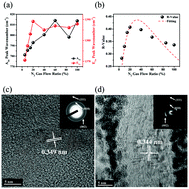Nitrogen-mediated aligned growth of hexagonal BN films for reliable high-performance InSe transistors†
Abstract
Orientation controlled hexagonal boron nitride (h-BN) films exhibit excellent mechanical and thermal properties, making them attractive for diverse applications. However, wafer-scale synthesis of vertically oriented h-BN films is still a significant challenge. Herein, utilizing high power impulse magnetron sputtering (HIPIMS) of up to around 500 W, a series of h-BN thin films have been directly deposited on silicon wafers in various nitrogen environments. Our analyses reveal that the degree of microstructure alignment of the as-grown films strongly depends on the nitrogen gas flow ratio. Between 20% to 40% gas flow ratios, defined to be the ratio of the nitrogen gas flow rate to the total gas flow rate of nitrogen and argon, the film attained its maximum alignment as measured by the R value. Correspondingly, the maximum thermal conductivity of the films occurs in the same region and the value ranges from 0.5 to 1.5 W m−1 K−1. Interestingly, such a BN-encapsulated InSe transistor shows a typical semiconductor characteristic and works well even after 2 months or longer. Additionally, the InSe transistor exhibits electro-dominated transport with high mobility (71.0 cm2 V−1 s−1) and performs well up to 200 °C. Our study suggests that alignment engineering in h-BN samples is plausible for thermal performance enhancement, which can broaden the thermal management applications in electrical and optoelectronic fields.



 Please wait while we load your content...
Please wait while we load your content...